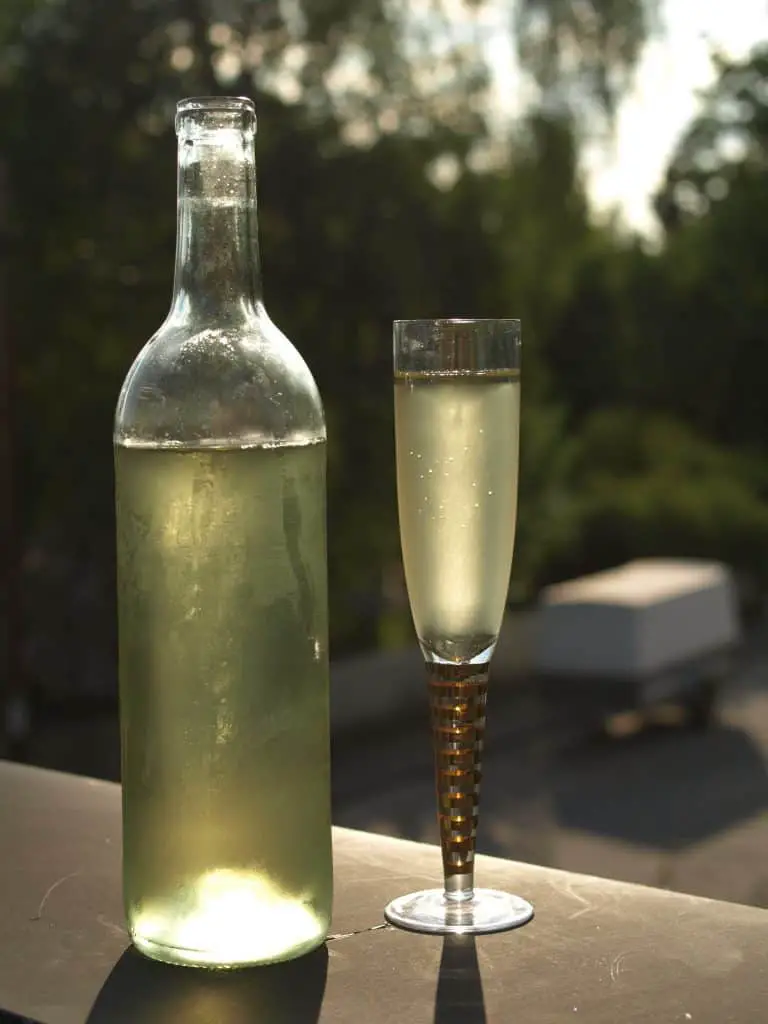Carbon Dioxide is one of the byproducts of fermentation that we do not want in the finished wine or still mead. It is toxic to yeast. It inhibits the yeast’s ability to ferment the larger amount of sugars in the wine. Get rid of any residual carbon dioxide left in solution after fermentation.
Carbon dioxide affects many things in wine or mead;
- Clarity
It is difficult to achieve crystal clear wines or meads when there is carbon dioxide in solution. The agitation will prevent yeast, proteins, and other particles in solution from flocculating. It also avoids it from settling to the bottom of the fermentation vessel.
- Flavor
Carbon dioxide in solution creates carbonic acid. In some drinks this is fine. Sparkling wines and fizzy beverages are going to have a more acidic palate. Carbonic acid bite overwhelms the balance of sweetness and flavor.
De-gassing the wine or mead is the answer.
The Importance of De-Gassing
Yeast when first pitched needs oxygen to grow strong and multiply. This is why it’s best to introduce oxygen either by oxygen tank setup. Also, you can use agitation of the wort before pitching the yeast. The gas emitted during the first few days of fermentation will be detrimental to health. It also affects the vigor of the yeast. That is why de-gassing is important during the primary fermentation.
In winemaking, de-gassing unbinds the CO2 from proteins. It makes it easier for the wine to clear completely after fermentation.
Temperature and time both affect the volume of residual carbon dioxide in the wine or mead. You have to extract all it by either stabilizing or bottling it before you finish the wine/mead.
When to De-Gas Mead?
Recommended de-gassing periods:
- Only one time
- After fermentation is over
- At temperatures above 70F, 75F (24C)
- Before adding a clarifier or after you’ve racked off of settled sediment
Going by these rules reduces the risk of unnecessary oxygen exposure. It avoids many degassing and undoing the work of clarifiers.
Ways to De-gas Mead
There are three main ways to remove carbon dioxide from wine/mead.
- Time
The simplest method to de-gas a wine or mead is to leave it long enough for the CO2 to disperse. Commercial wines age at least a year or two. It will not take years for all the CO2 to disperse and aging for 3 – 4 months is usually enough.
If you are aging the wine I would recommend longer than this. Be sure the wine does not sit on any sediment for too long as this will impart off-flavors.
- Agitation
Agitation is a common method of de-gassing wine for those who don’t want to wait for months for it to de-gas. The method is to stir or mix the wine enough so the carbon dioxide fizzes out using a brewing paddle or spoon. A variety of products are now available on the market to aid with this. De-gassing wands that attach to a drill make the job very easy.
To de-gas a wine or mead by agitation it can take a lot of stirring. It could take a few minutes at a time over the course of a week is a rough guide to the amount of agitation needed.
- Under vacuum
Creating a vacuum in the vessel creates negative pressure in the headspace. The negative pressure caused by a vacuum will force the carbon dioxide out of solution. It will rise to the top of the wine.
There aren’t many commercial examples on a homebrew scale for de-gassing wine via a vacuum. There are wine savers that connect to the openings of the bottles. This intends to hold the wine stored after releasing the vacuum. But, it is only for single bottles. It will need different modifications to mount them to a carboy or to other vessels. To de-gas wine by creating a vacuum still takes a while, as in, hours under constant vacuum.
The vacuum cannot be too strong or it will damage the carboy. The vacuum needs to be in a constant state. This process is not appropriate for those who make tons of wine that needs to transfer it to larger vessels.
- The Whip
The Whip is usually for de-gassing your homemade wines. It uses a drill and it is an optimally-shaped rod. The whip is attach to a hand-drill as a drill bit would. It agitates the wine and causes the CO2 gas to nucleate and release as bubbles.
It will de-gas your homemade wine without splashing it. This is important because splashing can cause air to saturate into the wine. It can promote oxidation if it becomes too excessive.
- It’s a lot less work. You stick it into the wine, pull the trigger, and let it do its thing.
Can You De-Gas Beer?
It depends. Still, the mead is not carbonated. Thus, the de-gassing process unbinds the CO2 from proteins. It makes it easier for the liquid to clear completely after fermentation.
Yet, CO2, of course, is desirable in beer, so one wouldn’t want to expel that after fermentation. There are phases of beer production on certain styles where de-gassing (diacetyl rest)… But that is for different reasons. Though, A diacetyl rest is not essential de-gassing. Yeasts consume diacetyl which is more active at higher temperatures.
How Do You Know When A Wine/Mead Is De-gassed?
Through agitation, De-gassing a wine/mead releases carbon dioxide. It will create foam on the surface of the wine/ mead. Agitating the wine like this is a good way to check how much CO2 is in the solution.
When foaming during agitation starts to subside, this is a good sign that you have degassed the wine.
In degassing, I prefer to use the following method:
- Take a sample of the wine in a hydrometer test jar. Cover the opening with your palm and give the sample a good shake.
- Keep an eye for obvious foaming and release the opening. If you hear or feel a noise like opening a fizzy drink the wine needs more degassing.
- Ample of the wine. Keep the wine in your mouth, and detect whether carbon dioxide is present.
- Some crisper or drier wines may be difficult to discern acidity and residual CO2. It takes some practice.
Tips and Guide for De-gassing Mead:
- Primary fermentation usually lasts 2 weeks.
- CO2 will come out of solution during the aging of a mead unless you are doing that in a sealed vessel. Every time you rack mead, it dissolves and releases more gas.
- Usually, fermentation is complete and all the bubbles are gone after 6 months or so. There are exceptions in the case of prolonged fermentations because of abnormal conditions.
- Before the extended lagering process, the lager’s primary fermentation performs a D-Rest. This would have the effect of increasing the beer temp from the low 50s to the mid-60s. This will force some CO2 out because of solubility limits.
- De-gassing is different from Aeration. De-gassing is trying to get the dissolved CO2 out of solution. Do it at least twice per day during the primary. Then tone it done a bit for secondary until fermentation is over. Next, the process stops releasing carbon dioxide from the process.

The Brewing Art is created to help dedicated homebrewers. My aim is to help people enjoy life and be committed to brewing for a better drinking experience. I also help starting entrepreneurs in the beverage industry pursue their passion by providing advice and information about quality brews.

